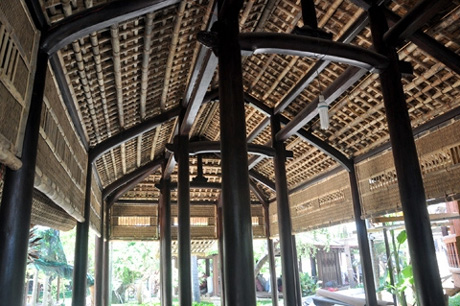Wooden Houses in Hoi An: Preserving a Structure, Preserving History

In Hoi An, a “virtual” town composed of 18 wooden houses and 15 other wooden structures stand as a musem of traditional architectural styles from different parts of Vietnam. Opened to the public in 2002, it has been a popular tourist destination since then because of the interesting fact that everything has been the work of one truly passionate carpenter.
Le Van Tang is a third generation of a carpenter family of the (once) famous Kim Bong Carpentry Village. A local officer by profession but an artist by heart, he finally left his job after 16 years into the service to pursue his first love. It has always been his dream to build and/ or restore wooden houses, specifically in his locality which had over 400 of them. These were history-rich abodes of more than 150 years old wasting away to destruction either because of the natural elements or the owner's lack of money to fix them. Restoring a wooden house sometimes cost five to six times more than tearing it down and building a new concrete one.
In pursuit of his dream and passion, Tang embarked on a life-changing decision by borrowing then VND2 million (today equivalent to over VND40 million) to buy and restore a house in Binh Nam Commune. After his work, he was surprised to be approached by several men and offered VND6 million for the house. When he refused, they doubled the offer. When he still said no, they raised the cost to VND28 million, to which Tang finally agreed but was shocked and surprised to know that such work could cost that much.
His first (unexpected) sale laid the groundwork for Tang, after which he continued buying and restoring old wooden houses. He bought even the badly dilapited ones to be used as materials for rebuilding other wooden houses. He would even buy a whole house even for only one part of it that he needed. And when he came across a well-preserved wooden house, the passionate artist in Tang made him approach the owner and ask permission to study the structure, which included making carbon copies of the abode's patterns and taking notes of its history. In fact, Tang is so skilled in his craft that he could tell the age or origin of a house even after it has been brought down.
In order to bring awareness to his work, Tang opened a workshop for 300 local carpenters and sculptors from Van Ha and Kim Bong Villages in Quang Nam Province. One of his greatest achievements was restoring a temple built to honor Ong Ich Khiem between 1831-1884. Tang and his workers replaced the whole rotten frame without removing the structure's roof and tiles. They also rebuilt a 140-year old four-storey French-style wooden house designed and owned by Ao Dai designer Si Hoang which was quite a challenging task since the client had specific, strict demands. The whole process took 40 carpenters and six months of labor.
Tang's eldest son Le Van Vinh has followed in his father's footsteps, accompanying him to work since he was a teenager and at present the director of Vinahouse Space, Tang's company and realization of his long-time dream. According to Tang, even a well-restored house is just 50-60 percent of its original condition because of the difficulty in finding highly-skilled and talented artisans today compared to the olden days. He only moves a house from its original site to a new one if and only if it is in danger of being completely destroyed by time or the natural elements or if the owner doesn't have enough money to rebuild it. Tang said that the process of restoration is a tedious one since it sometimes takes a long time to convince the owners to sell their old houses, sometimes lasting up to years.
But perhaps more than his skill and talent, Tang's success can be attributed to his passion and dedication for the craft, sometimes charging less than the actual restoration cost, even doing voluntary work for the sake of the art. He and his men would travel even to mountainous areas just to fix a tiny detail. Even after the restoration process, Tang's hands-on approach to his work is still evident as he attends housewarming ceremonies and even chooses the day to install the new family altar. Tang performs beyond what is obligated of him, the definition of a true artist.









